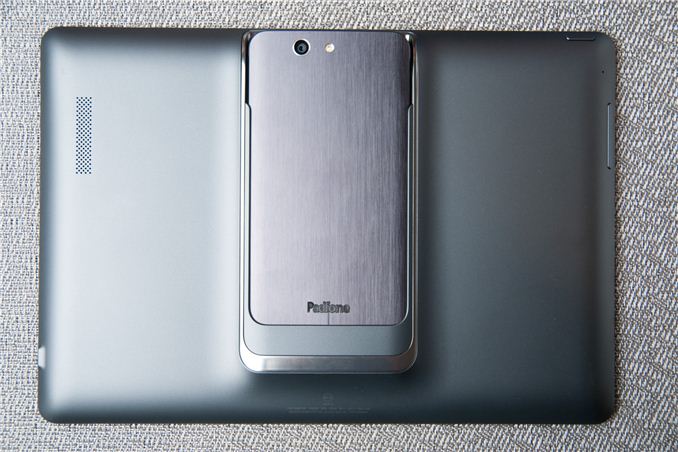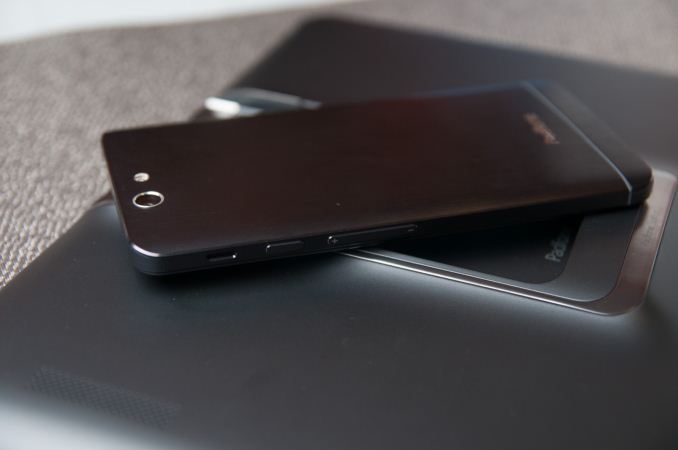Hands on with the new ASUS Padfone Infinity
by Brian Klug on September 17, 2013 9:00 AM EST- Posted in
- Smartphones
- Asus
- Mobile
- Padfone
- Tablets
- Android 4.2
- Snapdragon 800

For a while now, ASUS has been pushing form factor boundaries in the mobile space, with dockables and other 2-in-one platforms that once seemed radical but really started making sense after a while. I've been itching to get to try one such category for a while now, the Padfone, which combines 10.1-inch tablet form factor display and battery with a 5-inch form factor smartphone device. Compute resides in the smartphone form factor device, but when docked into the Padfone station, you bring everything over with you including connectivity, media, and the platform itself. ASUS has been selling the Padfone line for a while now, and we just recently received the new Padfone Infinity based on Snapdragon 800 to play around with.
The Padfone Infinity is based on a Snapdragon 800 platform with the 2.2 GHz Krait 400 clocks inside, and 450 MHz Adreno 330 GPU. There's also 2 GB of LPDDR3 alongside. I'll save the rest of the spec listing for the table, but the Padfone Infinity is absolutely bleeding edge in terms of both its camera, displays on both the smartphone and station, and SoC inside. I've only been playing with the Padfone for a short time, but UI is very smooth in both modes, and the transition between tablet and phone operation is very fast.
| ASUS Padfone Infinity | |
| SoC |
Qualcomm Snapdragon 800 (MSM8974) 4x Krait 400 2.2 GHz, Adreno 330 GPU |
| Display |
5-inch 1080p IPS (PadFone) 10.1-ich 1920x1200 IPS (PadFone Station) |
| RAM | 2 GB LPDDR3 RAM |
| WiFi | 802.11a/b/g/n/ac + BT 4.0 |
| Storage |
16/32 GB Internal, microSD slot (up to 64 GB), 50 GB ASUS WebStorage |
| I/O |
3.5mm headphone, nanoSIM, myDP (USB 2.0 host+device, 1080p video out) |
| OS | Android 4.2.2 |
| Battery |
2400 mAh (PadFone) 5000 mAh (PadFone Station) |
| Size / Mass |
143.5 x 72.8 x 8.9mm, 145 grams (PadFone) 264.6 x 181.6 x 10.6mm, 532 grams (PadFone station) |
| Camera |
2 MP w/AF, F/2.0 (Front) 13 MP w/AF,LED F/2.0 (Rear) |
| Network |
EDGE/GPRS/GSM: 850/900/1800/1900MHz
UMTS/DC-HSPA+: 850/900/1900/2100MHz
(DL: 42Mbit/s / UL: 5.76Mbit/s)
LTE Cat 4: 800/1800/2600MHz
(DL: 150Mbit/s, UL: 50Mbit/s) |
I've been wanting to take a look at the Padfone line for a long time regardless of the fact that there's no variant yet with USA-appropriate LTE bands. The other side of the Padfone is that US operators seem to be hostile to the form factor for some reason, of course it's an obvious way for consumers to get both tablet and smartphone under a single data plan.
I've been impressed with ASUS hardware build quality since playing with some of the earliest mobile devices, and it has continued to improve. The Padfone Infinity seems to have nailed the insert/eject force for the smartphone module, and the docking station tablet seems to be pretty solid. The industrial design is almost the same as the Padfone Infinity I played with at MWC earlier this year, though the new Padfone infinity adds a diamond cut edge to the rear of the phone to make it less sharp when held in the hand. I was impressed then with the use of metal on the smartphone module and continue to be impressed with both build quality and way that handset feels. I'm buried in smartphones and devices for this refresh period before the holidays, but we're definitely going to take a longer look at the Padfone Infinity.

















34 Comments
View All Comments
A5 - Tuesday, September 17, 2013 - link
One thing I've always wondered about these:What happens if you get a phone call in tablet mode? I assume it would just do a priority scheme like BT Headset > Speakerphone > ???, but it still seems kinda unwieldy for that situation.
nafhan - Tuesday, September 17, 2013 - link
Seems like it'd be pretty easy to just slide the phone out of the dock and answer it. Seems about as unwieldy as carrying two separate devices in that scenario.PixoSK - Tuesday, September 17, 2013 - link
I have the 1st version of Padfone and to ansver you can use BT or cable handsfree (both was part of package), pull the phone out or talk directly tu the tablet (same as when you have phone on loudspeak).madmish - Friday, November 22, 2013 - link
I have this new one, and you just slide it out and answer the call. It's super easy and you don't need to reboot anything; everything just transfers directly from phone to tablet to phone. It's a great phone, and I love not needing two interfaces, two SIM cards, synching, etc. It's basically all the benefits of two units, and the only time I can see the setup as being problematic is if you tend to use your tablet while talking on the phone. I would recommend it and would definitely buy it again.WhitneyLand - Tuesday, September 17, 2013 - link
So the tablet is useless without the phone?What scenarios is this intended for, to give less bulk when you need to have both tablet and phone available?
A5 - Tuesday, September 17, 2013 - link
I assume the idea is that you use the phone when you need to be mobile, then plug it into the tablet when you're stationary without losing any work/whatever.JeffFlanagan - Tuesday, September 17, 2013 - link
That's what I'd use it for if it worked with a US carrier. I currently carry a phone and a tablet most of the time, and only a phone part of the time. This would work as an all-in-one device for me.nathanddrews - Tuesday, September 17, 2013 - link
This would be the perfect CarPC. Mount the tablet to the dash, then just insert the phone every time you get in.Ikefu - Tuesday, September 17, 2013 - link
You don't need a second data plan for a tablet this way since your phone has LTE and IS the tablet.crimson117 - Tuesday, September 17, 2013 - link
It eliminates the need to keep two devices in sync. Just like a laptop dock lets you have a desktop experience while at work and a mobile experience on the go all with a single device, this allows a tablet experience at home (or wherever you carry it to) and a phone experience when a tablet is too cumbersome.